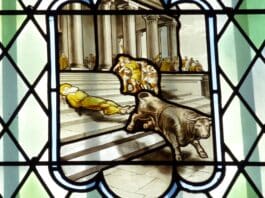
Saint Saturninus, under the guidance of Pope Fabian around 245 AD, journeyed to Gaul to spread the Christian faith, following in the footsteps of St. Trophimus, the first bishop of Arles, who had already cultivated a strong Christian community there.
By the year 250, during the consulship of Decius and Gratus, St. Saturninus established his episcopal seat in Toulouse. As Fortunatus notes, he successfully converted many pagans through his compelling preaching and the performance of miracles. This narrative of his life continues up to the point of his martyrdom.
St. Saturninus was known for his ability to silence oracles, believed to be the voices of devils, merely by his presence. Once, while passing by a pagan temple, he was recognized by the priests. They forcefully brought him into the temple, demanding he either offer sacrifices to their gods or face death as punishment for his defiance.
St. Saturninus fearlessly responded, declaring his worship of the one true God and denouncing the pagan gods as devils, more interested in the souls of their worshippers than their offerings. His bold declaration enraged the pagans, who subjected him to severe torment. In a final act of cruelty, they tied his feet to a wild bull, which was to be sacrificed, and set it loose.
The enraged bull dashed down a hill, causing St. Saturninus’ death through severe head injuries. His spirit ascended to heaven, leaving his mutilated body behind, which was eventually detached from the bull. His remains, scattered and bloodied, were respectfully collected by two pious women and hidden in a deep ditch to protect them from further desecration, resting in a wooden coffin until the reign of Constantine the Great.
Later, Hilary, the bishop of Toulouse, built a chapel over the burial site of St. Saturninus. In the late fourth century, Sylvius, another bishop of Toulouse, commenced the construction of a grand church in the saint’s honor. This church was completed by his successor, Exuperius, who ceremoniously transferred St. Saturninus’ relics into the church. These relics continue to be revered in that location to this day. The martyrdom of St. Saturninus likely occurred in 257 AD, during the reign of Emperor Valerian.
Photo credit: Reinhardhauke via Wikimedia Commons
The post Saint Saturninus appeared first on uCatholic.
Daily Reading
Monday of the Fourth Week of Advent
Reading 1 Mal 3:1-4, 23-24 Thus says the Lord GOD:Lo, I am sending my messengerto prepare the way before me;And suddenly there will come to the templethe LORD whom you…
Daily Meditation
Messages From Above
Click here for daily readings Have you ever thought about how many inspirations we may reject in one day because we don’t believe they were from God. The next question…




